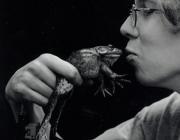Citation:
Abstract:
Sexually selected male weaponry is widespread in nature. Despite being model systems for the study of male aggression in Western science and for cricket fights in Chinese culture, field crickets (Orthoptera, Gryllidae, Gryllinae) are not known to possess sexually dimorphic weaponry. In a wild population of the fall field cricket, Gryllus pennsylvanicus, we report sexual dimorphism in head size as well as the size of mouthparts, both of which are used when aggressive contests between males escalate to physical combat. Male G. pennsylvanicus have larger heads, maxillae and mandibles than females when controlling for pronotum length. We conducted two experiments to test the hypothesis that relatively larger weaponry conveys an advantage to males in aggressive contests. Pairs of males were selected for differences in head size and consequently were different in the size of maxillae and mandibles. In the first experiment, males were closely matched for body size (pronotum length), and in the second, they were matched for body mass. Males with proportionately larger weaponry won more fights and increasing differences in weaponry size between males increased the fighting success of the male with the larger weaponry. This was particularly true when contests escalated to grappling, the most intense level of aggression. However, neither contest duration nor intensity was related to weaponry size as predicted by models of contest settlement. These results are the first evidence that the size of the head capsule and mouthparts are under positive selection via male-male competition in field crickets, and validate 800-year-old Chinese traditional knowledge


